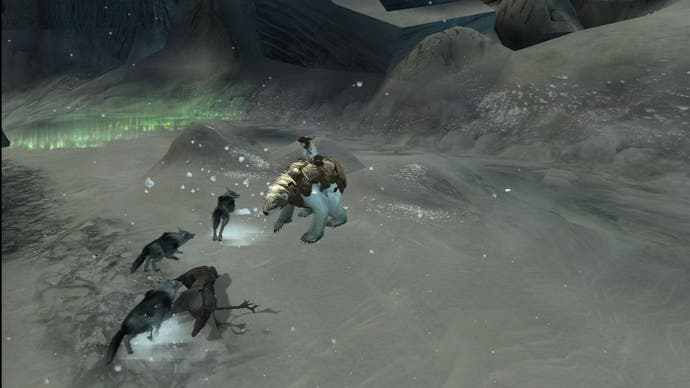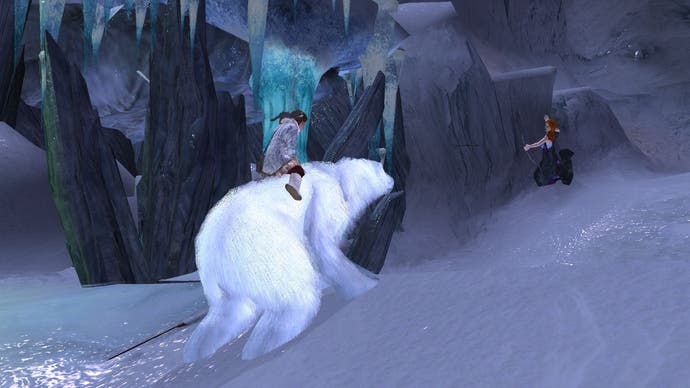The Golden Compass
Dark Material.
While no doubt some critics relish the chance to tear into a development team's latest creation with a firework display of cruel adjectives and poisonous put-downs, games journalists should always be reminded that behind every shoddy release there are many man years' worth of hard work, unpaid overtime and neglected families.
Nobody but nobody sets out wanting to make a bad game. When you've tried your best with the limited resources, assets and time available, carefully balancing your design ideas with a movie studio's agenda in a precarious compromise, rushing against all odds to get your game out on the same day as the movie, having some oblivious critic gleefully walk all over your efforts must sting. Imagine being asked to create a game that identically follows the events and aesthetics of a film that hasn't even been shot yet? It must be development purgatory. So, before we get started, know this SEGA and Shiny: we understand. We sympathise.
But we also remember that on the other side of this sorry equation sits Timmy, a twelve-year-old 360 owner hoping for Skate or PGR4 this Christmas. His mother, nervous about videogame stores and their sweaty clientele and chunky staff, instead walks into Woolworths, scans the shelves for a suitable present for her son and settles, naturally enough, on the warm familiarity of The Golden Compass. He liked the book and she's seen the film's advertisements on the side of the bus and, besides, it's got Nicole Kidman and James Bond in it, so it must be good, right? She doesn't know how these things work. She doesn't know the rules and little Timmy will have a rotten Christmas because of it.

The development team and Timmy: two very different people at either end of this game's life, experiencing curiously similar feelings of frustration and letdown. When it comes to videogames of movies, nobody wins. At least, nobody Eurogamer cares about.
So, the videogame of the film of the book, Northern Lights by Philip Pullman - the J. K. Rowling it's kind of OK to admit you like. Through the game you get to play as both Lyra Belacqua, a young girl on a Schindler's List style mission to save a group of kidnapped children, and her companion Iorek Byrnison, a huge armoured polar bear. Control of each character is spread evenly over the game's chapters and it plays quite differently for each. As Iorek you're in a scrolling beat-'em-up, button-mashing combo paw strikes and leaping icebergs. As Lyra you're creeping about university grounds, London apartments and sea galleons searching for clues, evading capture and divining the future from your alethiometer compass.
On start-up it's immediately apparent that the game has been developed for the PlayStation 2 and simply ported over to the 360 without graphical or technical upgrade. Character models lack texture detail, animations stutter and fail to flow into one another seamlessly, collision detection is fuzzy and the environments are relentlessly bare and uninteresting. The game opens with a prelude in media res during which you control Iorek as he streaks across icy landscapes, Lyra on his back, fighting wolves and leaping gaps. Control of the bear is passable with two basic moves to play with: swipe and block. Combination button presses provide a handful of special moves while you fill a rage meter as you fell enemies. Jumping the gaps that come into your path through the linear levels is handled in a semi-QTE fashion, with a Y-button input appearing every time you get near a suitable edge. It's all terribly pedestrian and, thanks to the poor hit detection and jittery animation the fighting and 'exploring', such that it is, is uninteresting.
Iorek's move list only widens by a tiny fraction as the game progresses and while there are a few additional tasks he has to carry out through the game (for example shoveling snow onto huts to put out flames) it's far too repetitive and linear to be enjoyable. For the rest of the game you're controlling Lyra where there's an opposite problem: you're hit with a barrage of different game mechanics, none of which are introduced well or explored thoroughly. Lyra's tasks are divided into three main elements: exploring and searching for clues, fighting and conversing.

Conversing is a tortured process where, each time you initiate a conversation, your reply is dictated by whether you pass or fail at a microgame. These are made up of simple block puzzles where you have to dodge the red blobs or collect the green blobs and other such sub-Wario-Ware tasks against the clock. Succeed in the task and Lyra will give the 'good' answer thus extracting whichever piece of information you're after from the interviewee. Fail and you'll have to undertake the process again. Playing a whole microgame just to get to the next sentence in a conversation is a tortuous experience and, even though there's a large range of game types, the process is far too protracted to be any fun.
On those occasions you do get into scraps with other characters the battle system is so concerned with being sanitised and U-rated that it looks completely implausible. In a bizarre JRPG fashion each character faces the other and, at certain moments you're given a directional button input which, if successfully hit within the time window, causes Lyra to dive out of the way, wrong-footing her enemy so he crashes into a filing cabinet or some suchlike object. You repeat this process four or five times until the enemy's health is depleted and you can move on. The process takes too long, looks ridiculous and is yet another element of the game that relies on the lazy solution of QTE button presses.
When exploring environments the game works like a simple and clunky platformer. Lyra has a jump button and four special moves made available to her by the cat-like creature that sits on her shoulder. Named Pan, the creature is Lyra's daemon, a kind of spirit guide who never leaves her side. Pan has four different forms (Ermine, Sloth, Hawk and Wildcat) and, selecting each one with the d-pad changes Lyra's special move. When Pan is in his Sloth form Lyra can swing from poles using his whip-like arms; as a Hawk she is able to glide a short distance; as a Wildcat she can climb certain surfaces while, as an Ermine she can gather information about objects by pointing at them. Occasionally, to reach difficult platforms you'll need to switch between Pan's forms mid-air, swinging from a pole as the Sloth before gliding down as a Hawk, an awkward manual manoeuvre that results in some frustrating moments made all the worse by the fact that the only items hidden on such ledges are usually extra health or superfluous special items for making conversations or fight encounters slightly easier.

The final core element to the game mechanic is the titular Golden Compass, or alethiometer as it's known in the game. The complex device is a three-handed compass inscribed with 36 different drawn symbols around its rim. Lyra uses the compass to divine answers to questions she's asked in the game. Each of the game's 48 questions is made up of three abstract concept keywords, such as 'Cunning', 'Productivity' and 'Knowledge'. To answer the question Lyra must match each word to the symbol on the alethiometer that best represents the concept. For example, 'Cunning' becomes Snake, 'Productivity' becomes Bee and 'Knowledge' becomes Apple. Uncovering the meanings to the symbols throughout the game (thus making matching symbols to concepts easier) is a fairly compelling meta-game and this gameplay nugget is by far the most successful on offer.
Despite this one positive, The Golden Compass feels like an unfinished title. Chapters are disjointed and the attempts at narrative segues between scenes and tasks are a mess. Often you'll find a huge plot element has apparently occurred between one scene and the next but the game failed to mention it, a big issue for a game so religiously based upon the narrative progression of the film. Added to this is a litany of niggles and flaws that reveal how rushed the game actually was: levitating puddles, character's lips that fail to move when they are talking, different voice actors to those in the film (confusing as you hear both thanks to the interspersed film clips), lines of dialogue that clip, unnecessarily fussy button inputs (for example, hit Y to get on and get off ladders), the five seconds it takes to call up your journal to check what you're meant to be doing next, as well as what is comfortably the worst stealth level ever committed to code.
The ideas aren't all bad and on paper this must have sounded like a rich and promising game. However, the game far overreaches itself and the coding, visuals and execution of those ideas is comprehensively unpolished. The problems with The Golden Compass are, of course, symptomatic of wider problems with the cancerous videogame tie-in genre. Trying to turn each narrative scene from a film into an interactive game is an exercise in wrong-headed futility. While movie studios continue to want a tie-in videogame hitting shop shelves on the same day that the movie itself hits cinemas, the quality of these games will never improve. Had the game had another six months to a year of development time, many of its problems and rough edges might have been smoothed and the score below perhaps doubled, a fact that will bring little comfort to either the development team or little Timmy this Christmas.

